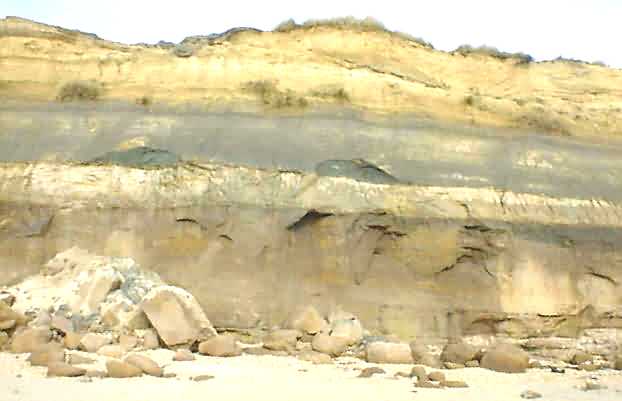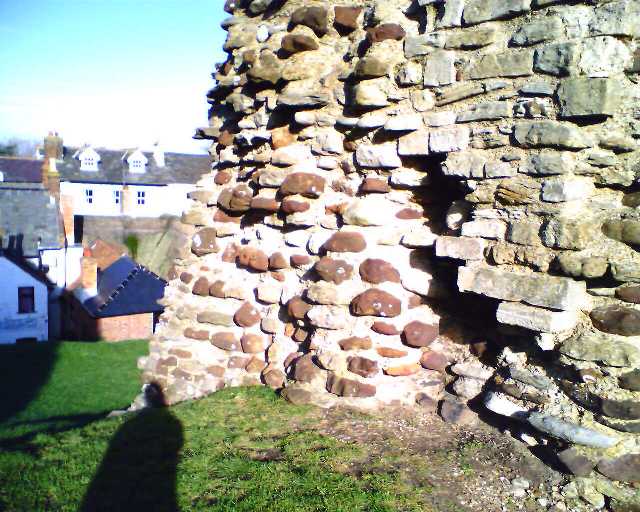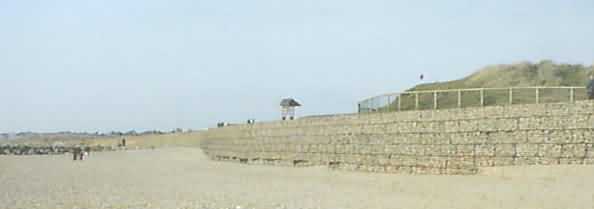Hengistbury Head Coastal Protection and Erosion
Erosion has been a continuous factor at Hengistbury Head since the sea finally reached its base a few thousand years ago. However, Hengistbury Head was provided with a natural defence in the form of heavy Ironstone Doggers that fell from crumbling cliffs to the beach below and built protective barriers, both on the beach and off shore. Consequently erosion at Hengistbury Head was a slow if not stationary process. The area had been stable for around 2000 years.
However the Ironstone Doggers gained their name from the fact that they could provide good quality iron ore. Some of the Doggers have been found to contain 30% by weight Siderite (Iron(II) Carbonate) which is a valuable Iron Ore. Their use and exploitation dates back to pre-history but every age since the Iron-Age has exploited the rusty red coloured stones.

Taken in 2001. A pile of talus from a recent collapse waits to be reduced to sand, while a small number of Ironstone doggers begin their new job as protectors of the cliff
In the 11th century some of the Ironstone Doggers were used in the construction of Christchurch Castle. Later in the 17th century many tons were used to build Clarendons Jetty (also now called the Long Rocks). Longshore drift closed Yarrantons cut through Mudeford sandspit in the early years of the 18th century rendering Clarendons Jetty useless. By then it would appear that erosion was taking a hold. Later in the 18th century Smeaton recorded that Hengistbury Head was suffering major erosion, confirming that erosion has already a factor people were aware of in the late 18th century.
The major erosion mechanism effecting Hengistbury Head is driven Longshore Drift. After the Ironstone Doggers had been removed, the sea had greater access to the fine sands on the beach. In storm conditions particularly, sand from the beach was washed away and the cliffs undermined. This caused sections of the cliff face to collapse. The prevailing wind in this region is from the South West. The waves normally break on the shore at an angle, driving in from the South-West. The energy from these waves is absorbed on the beach and the water then runs back to the sea at 90 degrees to the shorline. As the wave comes into the beach and as the water depth shallows, the wave picks up sediment. After crashing on the beach the water from the wave retreats from the beach carrying sand away. Beach building or beach depletion depends on whether or not the waves drop more material than they carry away. With Hengistbury Head more material is carried away than is dropped so without intervention the quantity of material that makes up the beach diminishes. As the sand grains are removed they are eventually replaced by sand from the the soft rock (talus) from the fallen cliff face. The process at Hengistbury Head would have continued until Hengistbury Head was completely washed away unless remedial action had been taken.

The tell-tale rusty-red Irondoggers incorporated into Christchurch castle
The original natural defence against Long Shore Drift has been provided by the large Ironstone doggers that had fallen to the beach from the eroded Upper Hengistbury Beds. They were usually far too heavy to be shifted by the sea and so formed a defensive barrier on the beach and also, they formed a reef like structure off-shore. This reef absorbed a great deal of the energy of the attacking waves and also contained the sand washed off the beach. Because of these natural defences the loss of material from Hengistbury Head was at least partially arrested. The beach and cliffs remained stable.
Erosion is a problem within the whole area. Bournemouth cliffs and the nearby coastline and cliffs at Highcliffe and Barton also having suffered large scale land loss.
Bournemouth cliffs were initially stabilised by the construction of a concrete promenade. This however did not stop the beach losing material. Deprived of fresh sand from the cliffs the beach diminished. Groynes were built to help prevent the drift of material eastwards. The consequent containment of loss of material from Bournemouth cliffs reduced the amount of material transported eastwards and so the arrival of new material at Hengistbury Head decreased. Now a beach recharge every seven to ten years, where up to a million cubic meters of sand is added to Bournemouth Beaches as a sacrifical loss is used to support both Bournemouth Beaches and Hengistbury Head. The building of new groynes at Hengistbury Head and also along the length of Mudeford Sandspit has also helped to contain this loss. Highcliffe had a very large concave beach defence erected in the 1960's below Steamer Point and considerable work has also been done at nearby Barton. Interestingly the beaches at Mudeford and Highcliffe have built up considerably in the last 30 years. The northern end of Mudeford Spit has also been reinforced with a rock groyne
The new sea defences erected at Bournemouth and at Hengistbury Head as well as the regular beach recharge have have significantly slowed erosion at Hengistbury Head. However there remains some concern of a breach across barn Field which would turn Hengistbury Head into an Island. There are mixed opinions regarding this possibility with some considering such a disaster almost inevitable within the next 50 years while others (arguably the more expert opinion) put the risk at 3% or less.
Hengistbury Head Defence Schemes - Beach Replenishment
Since the mid 70's beach recharge has been a method used to add material to the beaches along Bournemouth Bay. Mostly the recharge is done using sand dredged up off the Isle of Wight though once, to save money, material from the dredging of the entrance to Poole Harbour was used. Once (2005?) shingle was used to recharge the beach at Hengistbury Head rather than sand. Because it is heavier shingle is less prone to longshore drift than sand. However shingle is a much rarer resource than sand and is therefore a more expensive option. Major beach replenishment last took place near Hengisbury Head (just to the west at Southbourne Beach and Fishermans Walk) in 2010 using sand.
The business end of the dredgers sand pumping system on the beach waiting to be fitted. I believe this end is the end that attaches to the Dredger
The thick steel pipes are stacked on the beach ready for assembly
The method used during this beach replenishment involved building a temporary 50 cms (approx) diameter pipeline from the beach to a dredger, which moored about 300 meters off the shore. The dredger pumped sand as a slurry through the pipe to the beach. The crucial part of this operation is the floating of the semi-rigid pipe into shore where it is then connected to 20 meter (approx) sections of rigid steel tubing. This is built on the beach and is used to distribute the sand/water slurry over the beach. In order to ensure that there is not too much lateral force on the pipe a tug is positioned half way from dredger to beach and prevents the tide buckling the pipe.
The other end of the business end. Notice the pipe is semi flexible.
The pipe is floated out. A tug holds the pipe midway. The pipe will soon be flooded and will partially sink
Hengistbury Head Defence Schemes - Gabion Revetment
Along with a set of new groynes either side of the original 1938 long groyne a Gabion Revetment has been built to protect the weakest point in the eastern end of Hengistbury Head, on the South beach just before Hengistbury Head rises up to Warren Hill. While this thing is hardly a picture of Beauty it does provide an effective defence and will hopefully prevent Hengistbury Head becoming Hengistbury Island. One major problem with the gabion revetments is their life span. Inevitably, as they exist in a very harsh environment, their useful life is limited. (Update 2024 -see The New Long Groyne 2024

A Gabion Revetment at Hengistbury Head. Hardly a thing of beauty, but effective none the less
Hengistbury Head Defence Schemes - Artificial Reef
One new and revolutionary idea that was mooted for the coastal defence of Hengistbury Head would have involved building an artificial reef just off the coast to effectively replace the ironstone doggers that were trawled up in the 1850's. However the reef ended up being built further west and was by all accounts has been an unmitigated failure. It would seem unlikely that the council would have the appetite for trying the idea again anytime soon.
Hengistbury Head Natures Defence - Ironstone Doggers
While all this human activity and hard work continues, Hengistbury Head is also lending a hand in its own defence. As the cliff has receded, the Ironstone Doggers have been slowly slipping down onto the beach and rebuilding the defences stolen by the Hengistbury Mining Company and others. It can be seen, on the beach at Hengistbury Head, that where Ironstone Doggers are most prevalent, the cliff has regressed less.